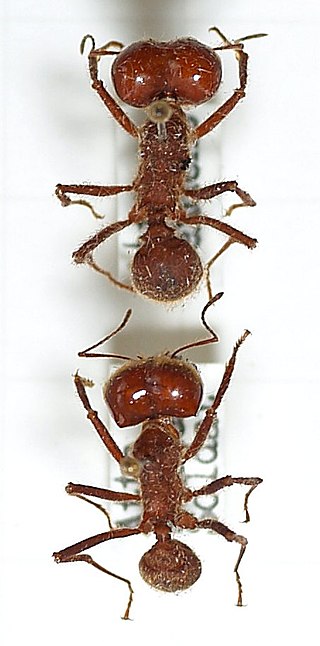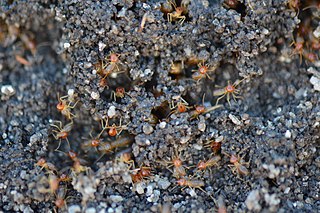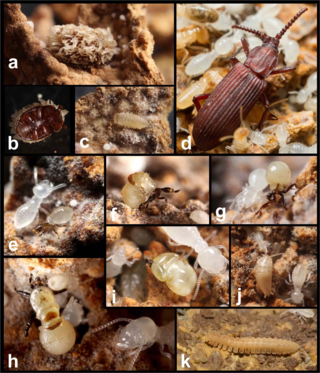
Termites are a group of detritophagous eusocial insects which consume a wide variety of decaying plant material, generally in the form of wood, leaf litter, and soil humus. They are distinguished by their moniliform antennae and the soft-bodied and typically unpigmented worker caste for which they have been commonly termed "white ants"; however, they are not ants, to which they are distantly related. About 2,972 extant species are currently described, 2,105 of which are members of the family Termitidae.

Leafcutter ants, a non-generic name, are any of 47 species of leaf-chewing ants belonging to the two genera Atta and Acromyrmex. These species of tropical, fungus-growing ants are all endemic to South and Central America, Mexico, and parts of the southern United States. Leafcutter ants can carry twenty times their body weight and cut and process fresh vegetation to serve as the nutritional substrate for their fungal cultivates.

Atta sexdens is a species of leafcutter ant belonging to the tribe Attini, native to America, from the southern United States (Texas) to northern Argentina. They are absent from Chile. They cut leaves to provide a substrate for the fungus farms which are their principal source of food. Their societies are among the most complex found in social insects. A. sexdens is an ecologically important species, but also an agricultural pest. Other Atta species, such as Atta texana, Atta cephalotes and others, have similar behavior and ecology.

The Macrotermitinae, the fungus-growing termites, constitute a subfamily of the family Termitidae that is only found within the Old World tropics.

Macrotermes bellicosus is a species of Macrotermes. The queens are the largest of all termites species, measuring about 4.2 inches (110 mm) long when physogastric. The workers average 0.14 in (3.6 mm) in length and soldiers are slightly larger. Bellicosus means "combative" in Latin. The species is a member of a genus indigenous to Africa and South-East Asia.

Hodotermes is a genus of African harvester termites in the Hodotermitidae. They range from Palaearctic North Africa, through the East African savannas to the karroid regions of southern Africa. As with harvester termites in general, they have serrated inner edges to their mandibles, and all castes have functional compound eyes. They forage for grass at night and during the day, and their pigmented workers are often observed outside the nest.

Termitotrox cupido is a species of scarab beetle in the subfamily Termitotroginae. It was first described by Munetoshi Maruyama in 2012, having been discovered living inside a nest of the termite Hypotermes makhamensis in Cambodia. It is a tiny, blind and flightless insect.
Hypotermes makhamensis is a species of termite in the subfamily Macrotermitinae of the family Termitidae. It lives in dry evergreen forests in tropical south-eastern Asia and builds termite mounds in which it cultivates fungus for use as food.

Macrotermes michaelseni is a species of termite in the family Termitidae, found in sub-Saharan Africa. It is associated with the fungus Termitomyces schimperi.

Macrotermes is a genus of termites belonging to the subfamily Macrotermitinae and widely distributed throughout Africa and South-East Asia. Well-studied species include Macrotermes natalensis and M. bellicosus.
The sugarcane termite is a species of termite of the genus Odontotermes. It is native to India and Sri Lanka. It is recorded from coconut palms and is a pest of sugarcane.
The Fungus-growing termite,, also known as South Asian wood-destroying termite, is a small species of earth dwelling termite of the genus Odontotermes. It is native to India and Sri Lanka.
Odontotermes globicola is a species of small termite of the genus Odontotermes. It is native to India, Malaysia and Sri Lanka. It is found under flower pots and decaying logs. They construct small chambered nest with spherical combed termitaria.
Odontotermes redemanni, is a species of termite of the genus Odontotermes. It is native to India and Sri Lanka. It damages wooden constructions. It is a pest of sugarcane, tea and coconut. They construct termitaria during November to March when rainfall and ambient temperature become low. Underground termite nests of this species are a natural host for the important Traditional Chinese Medicine fungus Xylaria nigripes, also known as Wu Ling Shen.

Macrotermes carbonarius, also known as Kongkiak in Malay, is a large black species of fungus-growing termite in the genus Macrotermes. It is one of the most conspicuous species of Macrotermes found in the Indomalayan tropics, forming large foraging trails in the open that can extend several metres in distance. M. carbonarius is a highly aggressive species with the soldiers possessing large curving mandibles that easily break skin. It is found in Cambodia, Malaysia, Myanmar, Singapore, Thailand and Vietnam.

Amitermes hastatus, commonly known as the black mound termite, is a species of termite found in the Western Cape region of South Africa. It is endemic to the region's fynbos ecosystem. They build distinctive black termite mounds that range in height from a few centimeters to 50 centimeters. The species is commonly found on sandy soil eroded from white Table Mountain sandstone at altitudes from just under 100 meters up to 900 meters above sea level.

Odontotermes, commonly known as the fungus-growing termites, is a termite genus belonging to family Termitidae, which is native to the Old World. They are most destructive in wooden homes, and are agricultural pests in the tropics and subtropics of Africa and Asia. It is the most diverse termite genus in Africa, with 78 species recorded.
Amitermes floridensis, commonly known as the Florida darkwinged subterranean termite, is a species of eusocial insect in the family Termitidae. It feeds on rotting wood, reached by a network of tunnels. It is endemic to west central Florida and was first described in 1989.

Odontotermes formosanus is a species of fungus-growing termite in the family Termitidae. It is native to southeastern Asia and was first described from Taiwan. This termite cultivates a symbiotic fungus in a special chamber in the nest. Workers and soldiers gather vegetable detritus which they bring back to the colony, chewing the material to a pulp to make a suitable substrate on which to grow the fungus.

Constrictotermes cyphergaster is a Neotropical species of open-air foraging nasute termite within the genus Constrictotermes. This species is distributed widely throughout South America and lives within xeric habitats such as the savannas found in Paraguay, Bolivia, Central Brazil, and Northern Argentina. C. cyphergaster primarily builds arboreal and transient epigeic nests and mainly consumes dead woods at varying stages of decomposition.













